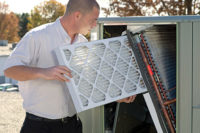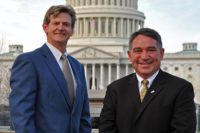As the economic recovery continues across the U.S., leaders in geothermal technology believe their share of the commercial market is poised for growth. And this optimistic outlook is bolstered by positive indicators across many sectors of the commercial market, including hospitality, education, government, and retail.
“We expect continued growth in geothermal in commercial applications this year due to continued demand for energy efficiency and comfort,” said Raj Hiremath, director of marketing for ClimateMaster Inc.
And while there are still barriers to the growth of geothermal, including high first cost and logistical challenges, experts believe these can be overcome through advancing technology and educational efforts.
Growth Sectors for Geothermal
“The education and hospitality sectors, as well as the government sector, are all strong for geothermal,” said Darcy Lee, product portfolio leader, Trane, an Ingersoll Rand brand. “This is due to increases in energy efficiency that geothermal offers combined with rebates that have been offered. Historically, lots of schools and hotels have used geothermal solutions, as have some government buildings, and even some multifamily living buildings, such as condos and apartments.”
Lee added, “Previously, the geothermal market, as a whole, had shrunk because the lodging industry, in particular, had overbuilt. Now that the markets have turned around, we’re seeing both new construction and renovations taking off.”
Jeff Miller, president of Earthlinked Technologies Inc., has also seen positive signs in the hospitality market for his company’s niche of geothermal hot water heating and dehumidification. “We’re serving several hotels using geothermal to heat a significant portion of their domestic water needs — potable water for in-room, as well as restaurant, food and beverage, and laundry,” he said.
Miller added that he has seen some small businesses in the hospitality sector take advantage of Small Business Administration (SBA) 504 loans by reducing their buildings’ total energy expense with a geothermal system.
Several manufacturers also stated that the education sector is continuing to be strong for geothermal, especially since the school market tends to seek green, efficient solutions.
“Both K-12 and college/university settings, whenever they are looking to build or renovate, demand efficiency and green technology,” said Richard Boothman, North American sales director, Modine Mfg. Co. “Geothermal is, in many cases, a perfect solution.”
Within the education market, Dick Hanna, director of product management, Bard Mfg. Co. Inc., pointed out that the success stories of other schools is propelling interest in geothermal systems.
“More architects and engineers are looking at these opportunities as they continue to see the success stories evolve,” Hanna said. “We see growth in both new construction and in renovation projects for existing schools for many years.”
While noting that the education market is especially productive for geothermal, Gonçalo Costa, director of product marketing, Bosch Thermotechnology Corp., also pointed to signs of potential in retail. He noted that Bosch installed the first geothermal system in an IKEA store in Colorado two years ago.
Doug Dougherty, president and CEO of the Geothermal Exchange Organization (GEO), elaborated on the promising signs in the retail sector, noting that in addition to IKEA, Walgreens, and McDonald’s have also recently installed geothermal heat pumps in select locations.
“For those corporations that have cookie-cutter retail outlets, it will be an easy energy analysis [to compare operational expenses between geothermal and traditional systems],” he said. “That’s why if corporations like IKEA, Walgreens, and McDonald’s became the early adopters, it will be good for us.”
In addition to hospitality, education, and retail, there are other sectors of the commercial market that are seeing significant geothermal activity, according to Hiremath. He said these include offices, assisted-living facilities, religious institutions, and multifamily buildings.
Plus, the government sector is also staying strong for geothermal.
“Geothermal is increasingly popular in the growing municipal building market,” said Alan Niles, Western region commercial sales manager, WaterFurnace Intl. Inc. “And U.S. military base projects continue to be strong.”
Looking at Life Cycle Costs
While the future looks bright, experts acknowledge that there are still barriers the geothermal industry must overcome to reach its growth potential.
The No. 1 challenge is always funding, Hanna said. Yet, while high first costs continue to deter end users, many believe that this obstacle can be conquered with the right mix of education, confidence, and analysis.
“Commercial geothermal jobs are no different than residential geothermal jobs. They usually carry a more burdensome install cost due to the requirement of the loop field. To get over this and put the customer at ease — whether it’s a hotel, school, or condominium developer — you need to have a confident sales and engineering team,” Boothman said. “It’s their job to explain to end users that geothermal solutions aren’t just a short-term fix or savings, but a long-term investment that helps out the business or school, as well as the environment and community.”
Lee stressed that analyzing the life cycle cost is the antidote to concerns about high first cost.
“The initial first-cost investment can be a barrier for some. This can potentially be overcome when the project is evaluated for its overall life cycle cost, which is typically lower than conventional solutions,” she said.
To alleviate concerns about high first cost, Miller said, “We’re focusing on empowering our dealer base to be able to share the message that the benefit [of installing a geothermal system] is the lifespan, the duration, and the value over time of this particular type of investment.”
He continued, “We’re seeing that, in the buying decisions, it’s really the trust of the delivery mechanism, or in this case, the installing contractor or selling agent to be able to communicate that effectively.”
Because of this, Earthlinked Technologies is training dealers on how to calculate true life cycle cost and return on investment instead of just simple payback. “The key takeaway is we’re really trying to empower dealers and installing contractors because our end users are looking to them for that confidence,” he said.
Another way the industry has been able to alleviate concerns about first costs is through the federal tax credits available for geothermal installations.
“The 10 percent tax credit [for geothermal installations on commercial projects] has a lot of sales cachet to it,” said Niles. He also noted that the Energy Efficient Commercial Building Property Tax Deduction and the accelerated depreciation, both of which expired at the end of last year, had been beneficial for geothermal sales.
“I hope to see both the 10 percent tax credit and these tax deductions extended as part of our overall national energy plan,” he said.
Hiremath noted that the 10 percent tax credit and accelerated depreciation have generated a lot of interest in commercial geothermal applications. However, he reiterated that the overall life cycle cost remains the most important factor.
“The tax credit helps the economics, but doesn’t completely tilt the economics,” he said. “It’s the long-term economics and LEED [Leadership in Energy and Environmental Design] that are actually driving the adoption of geothermal.”
Toppling Installation Barriers
Another barrier to installing geothermal systems has always been concerns about space and logistics. Or, in other words, Miller said, “People always ask, ‘Where do I put this stuff?’”
Today, however, new technologies and approaches are being promoted to eliminate this concern.
For those who think they don’t have enough room for a geothermal system, Miller said Earthlinked Technologies’ direct geo-exchange technology requires less area for installation.
“If you’re strapped for space, or if you’re in an urban environment, or if you’re looking to retrofit a particular commercial installation, or if solar doesn’t fit with your architectural guidelines, or if wind isn’t an option in your area, we offer a renewable energy solution,” he said. “We use a direct exchange process, so we use an excellent energy conductor, which is copper pipe, with a terrific heat exchange fluid, which is refrigerant. And we don’t have a lot of unnecessary pumps or heat exchangers in the circuit path. So it’s a much simpler transfer of heat from one place to another, and what that means is we need a lot less area to accomplish the same benefit.”
Another new product on the market designed to reduce consumer concerns about logistics is the Twister heat exchanger from Agreenability LLC. According to president Rob Jensen, the Twister is a high-efficiency heat exchanger that can reduce the bore field length for a geothermal system’s ground loop by 30 percent or more.
The patent-pending system of twisted pipes allows for the simultaneous installation of four loops in a single vertical bore. Jensen started selling the Twister in January 2013, and he said it has been especially popular in the Northeast because it reduces the amount of drilling needed in that region’s hard rock.
Another option in small spaces, according to Lee, is to install a hybrid geothermal system.
“Finding available land for a given geothermal project can be a challenge, especially with renovations. Hybrid ground-source systems, which add a cooling tower to the loop, are often an attractive option because they reduce the total land required for the ground heat exchanger,” she said.
Hiremath agreed, noting, “Designing hybrid geothermal systems also helps balance the upfront cost, efficiency, and confidence in system design to deliver comfort.”
Geothermal’s Bright, Green Future
Overall, the future looks bright for geothermal’s growth in the commercial market.
“We expect continuation of the growth trend seen in the last 20 years. Interest in geothermal is expanding as the energy savings and long-term durability become evident,” Costa said.
Boothman added that when it comes to geothermal, there is still a strong green element in the equation.
“The one trend that we see in regards to geothermal on the commercial side is that — as on the residential side — in many cases, the bottom line is you still need to have someone that wants geothermal. Geo saves you money, no doubt, but end users have to be a little green and must want it. Geo is just as much an emotional motivator for being green in addition to a fiscal motivator,” he said.
Publication date: 3/24/2014
Want more HVAC industry news and information? Join The NEWS on Facebook, Twitter, and LinkedIn today!















